BLOG - Page 24
Recently created mixtures:

Sea-Buckthorn Macerated oil
February 7, 2019

Home made air freshener
June 29, 2016

Homemade Dog-rose distillate
June 28, 2016

Homemade jasmine distillate
June 22, 2016

Moxibustion treatment with Moxa stick
May 30, 2016

Face and body gentle oil cleanser
May 26, 2016
BLOG / LATEST ADDITIONS!
Dry Rose Petals (Rosa Damascena) ☸ Ingredients ☸ Base / General
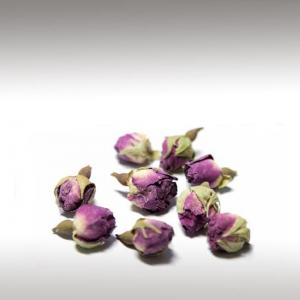

The distinctive scent of the Rose derived from acyclic monoterpene alcohols, geraniol (up to 75%), citronellol (20%) and nerol (20%), and long-chain hydrocarbons like nonadecane or heneicosane(up to 10%).
An important trace component of Rose oil is beta-damascenone. Even though this chemical makes up only 0.01% of the weight of the Rose, its presence or absence determines the appeal of the Rose.
Submitted by OperaDreamhouse (May 15, 2015)
Pomegranate Seed Oil (Punica Granatum) ☸ Base oils ☸ Base / General
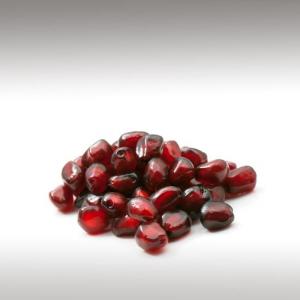

Pomegranate (Punica Granatum) member of the family Punicaceae, are one of the most ancient edible fruits. Corresponding to 55 - 60% of the whole fruit weight, of which 75 - 85% consists of juice and 25 - 15% consists of seed.
The Pomegranate, botanical name Punica Granatum, is a fruit-bearing deciduous shrub or small tree growing between 5 and 8 m tall. A shrub or small tree growing 6 to 10 m high, the pomegranate has multiple spiny branches, and is extremely long - lived, with some specimens in France surviving for 200 years.
The edible fruit is a berry, between a Lemon and a Grapefruit in size 5 - 12 cm in diameter with a rounded shape and thick, reddish skin. The number of seeds in a Pomegranate can vary from 200 to about 1400 seeds. Each seed has a surrounding water - laden pulp. The seeds are embedded in a white, spongy, astringent membrane.
The Pomegranate is considered to have originated in the region of modern day Iran, and has been cultivated since ancient times throughout the Mediterranean region and northern India. It was introduced into Latin America and California by Spanish settlers in 1769.
The fruit a long tradition of cultivation and back to ancient times. Numerous cultures regard the Pomegranate as a symbol of fertility due to its high number of seed, ranging from 150 - 200 to up to 1000.
Today, it is widely cultivated throughout the Middle East and Caucasus region, northern Africa and tropical Africa, the Indian subcontinent, Central Asia, and the drier parts of southeast Asia.
The name pomegranate derives from medieval Latin Pōmum "Apple" and Grānātum "Seeded".
The precious golden yellow to reddish oil is carefully extracted from dried Pomegranate kernels. It takes over 200 pounds of fresh Pomegranates seeds to produce just one pound of Pomegranate seed oil.
A relatively stable oil. Pomegranate seed oil is an extremely rich and nutritious oil. This highly prized oil, which is naturally high in flavonoids and punicic acid, is remarkable for the skin and has numerous dietary benefits as well.
Chemical structure:
Pomegranate seeds yeild a drying oil which contains pucinic acid forming upto 72% of the fatty acid.
Pucinic acid is conjugated triene and and geometrical isomer of elaostearic acid. Oil possesses antibacterial properties. Pomegranate (Punica Granatum) is now well known for antioxidant properties.
Free Fatty Acids - 2,8
Peroxide Value - 3,60
Specific Gravity - 0,939
Saponification Value - 190
Fatty Acids:
Linoleic - 7,1
Oleic - 6,2
Palmitic - 3,1
Punicic - 78,0
Stearic - 2,7
The Pomegranate, botanical name Punica Granatum, is a fruit-bearing deciduous shrub or small tree growing between 5 and 8 m tall. A shrub or small tree growing 6 to 10 m high, the pomegranate has multiple spiny branches, and is extremely long - lived, with some specimens in France surviving for 200 years.
The edible fruit is a berry, between a Lemon and a Grapefruit in size 5 - 12 cm in diameter with a rounded shape and thick, reddish skin. The number of seeds in a Pomegranate can vary from 200 to about 1400 seeds. Each seed has a surrounding water - laden pulp. The seeds are embedded in a white, spongy, astringent membrane.
The Pomegranate is considered to have originated in the region of modern day Iran, and has been cultivated since ancient times throughout the Mediterranean region and northern India. It was introduced into Latin America and California by Spanish settlers in 1769.
The fruit a long tradition of cultivation and back to ancient times. Numerous cultures regard the Pomegranate as a symbol of fertility due to its high number of seed, ranging from 150 - 200 to up to 1000.
Today, it is widely cultivated throughout the Middle East and Caucasus region, northern Africa and tropical Africa, the Indian subcontinent, Central Asia, and the drier parts of southeast Asia.
The name pomegranate derives from medieval Latin Pōmum "Apple" and Grānātum "Seeded".
The precious golden yellow to reddish oil is carefully extracted from dried Pomegranate kernels. It takes over 200 pounds of fresh Pomegranates seeds to produce just one pound of Pomegranate seed oil.
A relatively stable oil. Pomegranate seed oil is an extremely rich and nutritious oil. This highly prized oil, which is naturally high in flavonoids and punicic acid, is remarkable for the skin and has numerous dietary benefits as well.
Chemical structure:
Pomegranate seeds yeild a drying oil which contains pucinic acid forming upto 72% of the fatty acid.
Pucinic acid is conjugated triene and and geometrical isomer of elaostearic acid. Oil possesses antibacterial properties. Pomegranate (Punica Granatum) is now well known for antioxidant properties.
Free Fatty Acids - 2,8
Peroxide Value - 3,60
Specific Gravity - 0,939
Saponification Value - 190
Fatty Acids:
Linoleic - 7,1
Oleic - 6,2
Palmitic - 3,1
Punicic - 78,0
Stearic - 2,7
Submitted by OperaDreamhouse (May 14, 2015)
Arenarium Plant (Helichrysum Italicum) ☸ Plants ☸ Base / General
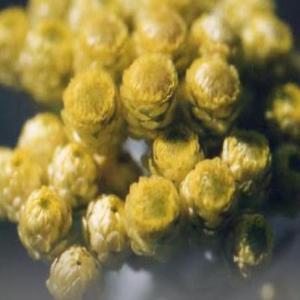

The genus Helichrysum consists of an estimated 600 species, in the Sunflower family Asteraceae. The type species is Helichrysum Orientale. The name is derived from the Greek words Helisso (to Turn Around) and Chrysos (gold).
It occurs in Africa, Madagascar, Australasia and Eurasia. The plants may be annuals, herbaceous perennials or shrubs, growing to a height of 60 - 90 cm.
It occurs in Africa, Madagascar, Australasia and Eurasia. The plants may be annuals, herbaceous perennials or shrubs, growing to a height of 60 - 90 cm.
Submitted by OperaDreamhouse (May 14, 2015)
Rose Petals ☸ Ingredients ☸ Base / General


In our world we have many species of Roses, so information will be presented in general side. We must have in mind that we are talking about organic plant withoutpollution.
A rose is a woody perennial of the genus Rosa, within the family Rosaceae. There are over 100 species and thousands of cultivars. Flowers vary in size and shape and are usually large and showy, in colours ranging from white through yellows and reds. Most species are native to Asia, with smaller numbers native to Europe, North America, and northwest Africa. Species, cultivars and hybrids are all widely grown for their beauty and often are fragrant.
The long cultural history of the rose has led to it being used often as a symbol. Roses are a favored subject in art and appear in portraits, illustrations, on stamps, as ornaments or as architectural elements.
The name rose comes from French, itself from Latin Rosa, which was perhaps borrowed from Oscan.
Bulgaria produces about 70% of all rose oil in the world. Other significant producers are Morocco, Iran and Turkey. Harvesting of flowers is done by hand in the morning before sunrise and material is distilled the same day.
There are three main methods of extracting the oil from the Rose Petals material:
Steam distillation, which produces an oil called Rose Otto or attar of Roses.
Solvent extraction, which results in an oil called Rose absolute.
Supercritical carbon dioxide extraction, yielding an essential oil that may be marketed as either an absolute or as a CO2 extract.
Chemical structure:
The most common chemical compounds present in Rose oil are:
citronellol, geraniol, nerol, linalool, phenyl ethyl alcohol, farnesol, stearoptene, α - pinene, β - pinene, α - terpinene, limonene, p - cymene, camphene, β - caryophyllene, neral, citronellyl acetate, geranyl acetate, neryl acetate, eugenol, methyl eugenol, rose oxide, α - damascenone, β - damascenone, benzaldehyde, benzyl alcohol, rhodinyl acetate and phenyl ethyl formate.
The key flavor compounds that contribute to the distinctive scent of rose are beta - damascenone, beta - damascone, beta - ionone, and Rose oxide.
A rose is a woody perennial of the genus Rosa, within the family Rosaceae. There are over 100 species and thousands of cultivars. Flowers vary in size and shape and are usually large and showy, in colours ranging from white through yellows and reds. Most species are native to Asia, with smaller numbers native to Europe, North America, and northwest Africa. Species, cultivars and hybrids are all widely grown for their beauty and often are fragrant.
The long cultural history of the rose has led to it being used often as a symbol. Roses are a favored subject in art and appear in portraits, illustrations, on stamps, as ornaments or as architectural elements.
The name rose comes from French, itself from Latin Rosa, which was perhaps borrowed from Oscan.
Bulgaria produces about 70% of all rose oil in the world. Other significant producers are Morocco, Iran and Turkey. Harvesting of flowers is done by hand in the morning before sunrise and material is distilled the same day.
There are three main methods of extracting the oil from the Rose Petals material:
Steam distillation, which produces an oil called Rose Otto or attar of Roses.
Solvent extraction, which results in an oil called Rose absolute.
Supercritical carbon dioxide extraction, yielding an essential oil that may be marketed as either an absolute or as a CO2 extract.
Chemical structure:
The most common chemical compounds present in Rose oil are:
citronellol, geraniol, nerol, linalool, phenyl ethyl alcohol, farnesol, stearoptene, α - pinene, β - pinene, α - terpinene, limonene, p - cymene, camphene, β - caryophyllene, neral, citronellyl acetate, geranyl acetate, neryl acetate, eugenol, methyl eugenol, rose oxide, α - damascenone, β - damascenone, benzaldehyde, benzyl alcohol, rhodinyl acetate and phenyl ethyl formate.
The key flavor compounds that contribute to the distinctive scent of rose are beta - damascenone, beta - damascone, beta - ionone, and Rose oxide.
Submitted by OperaDreamhouse (May 14, 2015)
Rose Petals ☸ Ingredients ☸ Food / Cooking


The fruits of many species have significant levels of Vitamins and have been used as a food supplement.
Rose flowers are used as food, also usually as flavouring or to add their scent to food. Other minor uses include candied Rose Petals.
Rose hips are occasionally made into jam, jelly, marmalade, and soup or are brewed for tea, primarily for their high Vitamin C content. They are also pressed and filtered to make Rose hip syrup.
Rose Petals or flower buds are sometimes used to flavour ordinary tea, or combined with other herbs to make herbal teas.
In France there is much use of Rose syrup, most commonly made from an extract of Rose Petals. In the United States, this French Rose syrup is used to make rose scones and marshmallows.
Rose creams (Rose flavoured fondant covered in chocolate, often topped with a crystallised Rose Petal) are a traditional English confectionery widely available from numerous producers in the UK.
Rose flowers are used as food, also usually as flavouring or to add their scent to food. Other minor uses include candied Rose Petals.
Rose hips are occasionally made into jam, jelly, marmalade, and soup or are brewed for tea, primarily for their high Vitamin C content. They are also pressed and filtered to make Rose hip syrup.
Rose Petals or flower buds are sometimes used to flavour ordinary tea, or combined with other herbs to make herbal teas.
In France there is much use of Rose syrup, most commonly made from an extract of Rose Petals. In the United States, this French Rose syrup is used to make rose scones and marshmallows.
Rose creams (Rose flavoured fondant covered in chocolate, often topped with a crystallised Rose Petal) are a traditional English confectionery widely available from numerous producers in the UK.
Submitted by OperaDreamhouse (May 14, 2015)
Ginger Essential Oil (Zingiber Officinale) ☸ Essential oils ☸ Base / General
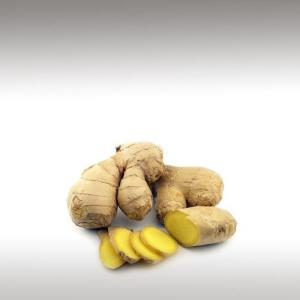

Botanical Name: Zingiber officinale
Common Method of Extraction: Steam distillation
Part Typically Used: Dried Root
Color: Golden yallow
Consistency: Thin
Perfumery Note: Middle
Strength of Initial Aroma: Spicy, warm, woody, with a deep earthy undertone.
Ginger is a flowering plant in the family Zingiberaceae whose rhizome, Ginger root or Simply Ginger. It is a herbaceous perennial which grows annual stems about a meter tall bearing narrow green leaves and yellow flowers. Every year it shoots up a stalk with narrow spear-shaped leaves, as well as white or yellow flowers growing directly from the root.
Ginger is indigenous to southern China, and was spread eventually to the Spice Islands, other parts of Asia and subsequently to West Africa and the Caribbean.
Ginger was exported to Europe via India in the first century AD as a result of the lucrative spice trade. India is now the largest producer of Ginger. Ginger comes from a Sanskrit word “Srngaveram” meaning “Horn Root”.
Ginger was one of the first products to travel the spice route from Asia to Europe, where both the Greeks and Romans made extensive use of it.
The aromas of the dried root distillation and fresh root distillation are quite different. The fresh root oil has a bright note in comparison, where the dried root oil has the traditional grounding rooty notes to the aroma. Both are very pleasant.
Ginger essential oil has an aroma that is a medium to strong scent that is warm, woody and spicy. It has undertones of Lemon and pepper with a middle to base note. It is a stimulating and uplifting aroma.
West African women in Senegal weave belts of Ginger to bring back their partners sexual interest.
Chemical strucute:
The essential oil has various chemical constituents including the following: a-pinene, camphene, b-pinene, 1,8-cineole, linalool, borneol, y-terpineol, nerol, neral, geraniol, geranial, geranyl acetate, b-bisabolene and zingiberene.
Common Method of Extraction: Steam distillation
Part Typically Used: Dried Root
Color: Golden yallow
Consistency: Thin
Perfumery Note: Middle
Strength of Initial Aroma: Spicy, warm, woody, with a deep earthy undertone.
Ginger is a flowering plant in the family Zingiberaceae whose rhizome, Ginger root or Simply Ginger. It is a herbaceous perennial which grows annual stems about a meter tall bearing narrow green leaves and yellow flowers. Every year it shoots up a stalk with narrow spear-shaped leaves, as well as white or yellow flowers growing directly from the root.
Ginger is indigenous to southern China, and was spread eventually to the Spice Islands, other parts of Asia and subsequently to West Africa and the Caribbean.
Ginger was exported to Europe via India in the first century AD as a result of the lucrative spice trade. India is now the largest producer of Ginger. Ginger comes from a Sanskrit word “Srngaveram” meaning “Horn Root”.
Ginger was one of the first products to travel the spice route from Asia to Europe, where both the Greeks and Romans made extensive use of it.
The aromas of the dried root distillation and fresh root distillation are quite different. The fresh root oil has a bright note in comparison, where the dried root oil has the traditional grounding rooty notes to the aroma. Both are very pleasant.
Ginger essential oil has an aroma that is a medium to strong scent that is warm, woody and spicy. It has undertones of Lemon and pepper with a middle to base note. It is a stimulating and uplifting aroma.
West African women in Senegal weave belts of Ginger to bring back their partners sexual interest.
Chemical strucute:
The essential oil has various chemical constituents including the following: a-pinene, camphene, b-pinene, 1,8-cineole, linalool, borneol, y-terpineol, nerol, neral, geraniol, geranial, geranyl acetate, b-bisabolene and zingiberene.
Submitted by OperaDreamhouse (May 7, 2015)
Calendula Essential Oil (Calendula Officinalis) ☸ Essential oils ☸ Base / General
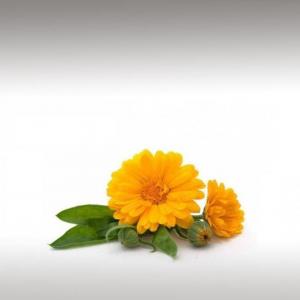

Botanical Name: Calendula officinalis
Common Method of Extraction: Carbon Dioxide distillation (SCO2 distillation) / CO2 Total Extract
Part Typically Used: Flowers
Color: Red / orange
Consistency: Sticky
Perfumery Note: Middle
Strength of Initial Aroma: Musky, woody, rotten, rather like the flowers themselves (waxy, warm and green/herbaceous scent)
Calendula or pot marigold, is a genus of about 15–20 species of annual and perennial herbaceous plants in the daisy family Asteraceae. They are native to southwestern Asia, western Europe, Macaronesia, and the Mediterranean.
The name calendula is a modern Latin diminutive of calendae, meaning "little calendar", "little clock" or possibly "little weather-glass". The common name "marigold" refers to the Virgin Mary.
Romans and Greeks used the golden calendula in many rituals and ceremonies, sometimes wearing crowns or garlands made from the flowers. One of its nicknames is "Mary's Gold", use in early Catholic events in some countries. Calendula flowers are sacred flowers in India and have been used to decorate the statues of Hindu deities since early times. Garlands of calendula were once attached to door handles to keep evil, particularly contagion, out of the house.
Calendula plant grows to a height of 60cm, has light green leaves, and daisy - like flowers which vary in colour from bright orange to yellow, and can bloom from May until the first frosts.
Calendula essential oil is distilled from the deep orange colored flowers. This SCO2 distillation is what would be considered the finest extracts available of this flower.
Chemical structure:
The principal constituents: Flavonoids, saponin, triterpene alcohol and a bitter principle.
The flowers of calendula officinalis contain flavonol glycosides, triterpene oligoglycosides, oleanane-type triterpene glycosides, saponins, and a sesquiterpene glucoside.
Common Method of Extraction: Carbon Dioxide distillation (SCO2 distillation) / CO2 Total Extract
Part Typically Used: Flowers
Color: Red / orange
Consistency: Sticky
Perfumery Note: Middle
Strength of Initial Aroma: Musky, woody, rotten, rather like the flowers themselves (waxy, warm and green/herbaceous scent)
Calendula or pot marigold, is a genus of about 15–20 species of annual and perennial herbaceous plants in the daisy family Asteraceae. They are native to southwestern Asia, western Europe, Macaronesia, and the Mediterranean.
The name calendula is a modern Latin diminutive of calendae, meaning "little calendar", "little clock" or possibly "little weather-glass". The common name "marigold" refers to the Virgin Mary.
Romans and Greeks used the golden calendula in many rituals and ceremonies, sometimes wearing crowns or garlands made from the flowers. One of its nicknames is "Mary's Gold", use in early Catholic events in some countries. Calendula flowers are sacred flowers in India and have been used to decorate the statues of Hindu deities since early times. Garlands of calendula were once attached to door handles to keep evil, particularly contagion, out of the house.
Calendula plant grows to a height of 60cm, has light green leaves, and daisy - like flowers which vary in colour from bright orange to yellow, and can bloom from May until the first frosts.
Calendula essential oil is distilled from the deep orange colored flowers. This SCO2 distillation is what would be considered the finest extracts available of this flower.
Chemical structure:
The principal constituents: Flavonoids, saponin, triterpene alcohol and a bitter principle.
The flowers of calendula officinalis contain flavonol glycosides, triterpene oligoglycosides, oleanane-type triterpene glycosides, saponins, and a sesquiterpene glucoside.
Submitted by OperaDreamhouse (May 6, 2015)
Cajeput Essential Oil (Melaleuca Cajeputi) ☸ Essential oils ☸ Base / General
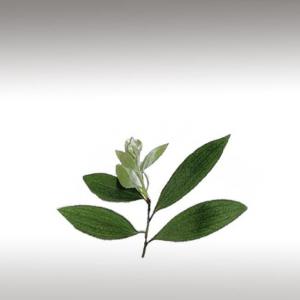

Botanical Name: Melaleuca cajeputi
Common Method of Extraction: Steam distillation
Part Typically Used: Fresh leaves and twigs
Color: Pale yellow
Consistency: Light
Perfumery Note: Middle
Strength of Initial Aroma: extremely pungent, has the odor of a mixture of turpentine and camphor.
The name “cajeput” is derived from its Indonesian name, “kayu putih” or "white wood".
Cajeput essential oil, Melaleuca cajuputi, also called White tea tree essential oil, White tree essential oil, and Swamp tea tree essential oil, is closely related to other members of the Melaleuca group, notably eucalyptus, niaouli, and tea tree.
Cajeput oil is a volatile oil obtained by distillation from the leaves of the myrtaceous tree Melaleuca leucadendra.This tree is also called the Melaleuca cajeputi and the Cajeput oil tree. The trees yielding the oil are found throughout Maritime Southeast Asia and over the hotter parts of the Australian continent. The majority of the oil is produced on the Indonesian island of Sulawesi.
This tree has thick white wood. It is found in Australia, the islands between Australia and Malaysia and in Indonesia. Other species of Melaleuca may also be used to make cajeput oil, like Melaleuca minor. The oil is distilled from the leaves and twigs of this tree. However, before distillation, the mixture is fermented for some time. Since the oil is steam distilled, it is organic and retains its original nutrients.
The flexible trunk has a white spongy bark that flakes off easily. The trees, and especially the essential oils, are held in high regard throughout the East.
The oil is prepared from leaves collected on a hot dry day, macerated in water, and distilled after fermenting for a night.
Also sometimes referred to as the white tea tree, the cajeput tree originated from the Malayan coastal plains. An evergreen, vigorous growing tree, it can reach 30 meters and has a whitish spongy bark with a crooked trunk. It is known in ancient India as Kayaputi and was also revered in the East for all its uses.
Chemical structure:
The main chemical components of Cajuput oil include a-pinene, b-pinene, myrcene, a-terpinene, limonene, 1,8-cineole, y-terpinene, p-cymene, terpinolene, linalool, terpinen-4-ol and a-terpineol.
Common Method of Extraction: Steam distillation
Part Typically Used: Fresh leaves and twigs
Color: Pale yellow
Consistency: Light
Perfumery Note: Middle
Strength of Initial Aroma: extremely pungent, has the odor of a mixture of turpentine and camphor.
The name “cajeput” is derived from its Indonesian name, “kayu putih” or "white wood".
Cajeput essential oil, Melaleuca cajuputi, also called White tea tree essential oil, White tree essential oil, and Swamp tea tree essential oil, is closely related to other members of the Melaleuca group, notably eucalyptus, niaouli, and tea tree.
Cajeput oil is a volatile oil obtained by distillation from the leaves of the myrtaceous tree Melaleuca leucadendra.This tree is also called the Melaleuca cajeputi and the Cajeput oil tree. The trees yielding the oil are found throughout Maritime Southeast Asia and over the hotter parts of the Australian continent. The majority of the oil is produced on the Indonesian island of Sulawesi.
This tree has thick white wood. It is found in Australia, the islands between Australia and Malaysia and in Indonesia. Other species of Melaleuca may also be used to make cajeput oil, like Melaleuca minor. The oil is distilled from the leaves and twigs of this tree. However, before distillation, the mixture is fermented for some time. Since the oil is steam distilled, it is organic and retains its original nutrients.
The flexible trunk has a white spongy bark that flakes off easily. The trees, and especially the essential oils, are held in high regard throughout the East.
The oil is prepared from leaves collected on a hot dry day, macerated in water, and distilled after fermenting for a night.
Also sometimes referred to as the white tea tree, the cajeput tree originated from the Malayan coastal plains. An evergreen, vigorous growing tree, it can reach 30 meters and has a whitish spongy bark with a crooked trunk. It is known in ancient India as Kayaputi and was also revered in the East for all its uses.
Chemical structure:
The main chemical components of Cajuput oil include a-pinene, b-pinene, myrcene, a-terpinene, limonene, 1,8-cineole, y-terpinene, p-cymene, terpinolene, linalool, terpinen-4-ol and a-terpineol.
Submitted by OperaDreamhouse (May 6, 2015)
Cajeput Essential Oil (Melaleuca Cajeputi) ☸ Essential oils ☸ Medicine / Health


Children: Avoid topical use on children under 6.
Submitted by OperaDreamhouse (May 6, 2015)
Allspice Essential Oil (Pimenta Dioica) ☸ Essential oils ☸ Base / General
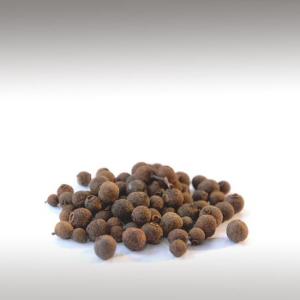

Botanical Name: Pimenta dioica
Common Method of Extraction: Steam distillation
Part Typically Used: Leaves and fruits
Color: Yellow - brown
Consistency: Thin
Perfumery Note: Top
Strength of Initial Aroma: Warm, spicy, woody scent with a mild camphor-like note, like a combination of cinnamon, clove and pepper.
Allspice is so called pimento because it tastes like a combination of cloves, juniper berries, cinnamon and pepper.
The oil has a sweet, spicy, clove - like odor, fruitier than the pimenta leaf oil which is less expensive. It has a fresh and clean top note and a long - lasting, sweet, balsamic - spicy body note with hints of tea - like undertones.
In perfumery, Allspice oil is typically used as a modifier in men’s fragrances, particularly in spicy fougeres and in oriental types.
Allspice, also called Jamaica pepper, Pepper, Myrtle pepper, Pimenta, Turkish Yenibahar, Pimento, English pepper or Newspice, is the dried unripe fruit of Pimenta dioica, a midcanopy tree native to the Greater Antilles, southern Mexico, and Central America, now cultivated in many warm parts of the world.
The name "Allspice" was coined as early as 1621 by the English, who thought it combined the flavour of Cinnamon, Nutmeg, and Cloves.
The tree begins to fruit when three years old and is in full bearing after four years. The flowers appear in June, July and August and are quickly succeeded by the berries.
The special qualities of the fruit reside in the rind of the berries. It loses its aroma on ripening, owing to loss of volatile oil, and the berries are therefore collected as soon as they have attained their full size, in July and August, but while unripe and green.
It begins to produce fruit in its third year, with each fruit containing two kidney-shaped green seeds, which turn glossy black when ripe.
The Allspice tree, classified as an evergreen shrub, reaches heights between 10 and 18 m. Allspice can be a small, scrubby tree, quite similar to the Bay laurel in size and form. It can also be a tall, canopy tree, sometimes grown to provide shade for Coffee trees planted underneath it. It can be grown outdoors in the tropics and subtropics with normal garden soil and watering.
Allspice was encountered by Christopher Columbus on the island of Jamaica during his second voyage to the New World. It was introduced into European and Mediterranean cuisines in the 16th century. It continued to be grown primarily in Jamaica, though a few other Central American countries produced Allspice in comparatively small quantities.
Despite its popularity, cultivation outside its native region has been uncommon and often unsuccessful. Allspice thrives in warm climates and grows almost entirely in the western hemisphere. Due to its limited range, it is not well known in many parts of the world.
Chemical structure:
The main chemical components of Allspice oil are eugenol, menthyl eugenol, cineol, phellandrene and caryophyllene.
Allspice fruits contain 2 to 5% essential oil. The main components of the essential oil areeugenol, eugenol methyl ether, myrcene, 1,8-cineol and alpha-phellandrene. The eugenol content of essential oil of Jamaican allspice is 65 to 90%, but the eugenol content of Mexican allspice is much less.
Because of the high eugenol content (50-75%), Allspice oil is one of a handful of essential oils with a density slightly greater than water. There have been reports of a methyl eugenol chemotype of this oil as well, but the typical berry oil will contain 10-25%methyl eugenol anyway.
Common Method of Extraction: Steam distillation
Part Typically Used: Leaves and fruits
Color: Yellow - brown
Consistency: Thin
Perfumery Note: Top
Strength of Initial Aroma: Warm, spicy, woody scent with a mild camphor-like note, like a combination of cinnamon, clove and pepper.
Allspice is so called pimento because it tastes like a combination of cloves, juniper berries, cinnamon and pepper.
The oil has a sweet, spicy, clove - like odor, fruitier than the pimenta leaf oil which is less expensive. It has a fresh and clean top note and a long - lasting, sweet, balsamic - spicy body note with hints of tea - like undertones.
In perfumery, Allspice oil is typically used as a modifier in men’s fragrances, particularly in spicy fougeres and in oriental types.
Allspice, also called Jamaica pepper, Pepper, Myrtle pepper, Pimenta, Turkish Yenibahar, Pimento, English pepper or Newspice, is the dried unripe fruit of Pimenta dioica, a midcanopy tree native to the Greater Antilles, southern Mexico, and Central America, now cultivated in many warm parts of the world.
The name "Allspice" was coined as early as 1621 by the English, who thought it combined the flavour of Cinnamon, Nutmeg, and Cloves.
The tree begins to fruit when three years old and is in full bearing after four years. The flowers appear in June, July and August and are quickly succeeded by the berries.
The special qualities of the fruit reside in the rind of the berries. It loses its aroma on ripening, owing to loss of volatile oil, and the berries are therefore collected as soon as they have attained their full size, in July and August, but while unripe and green.
It begins to produce fruit in its third year, with each fruit containing two kidney-shaped green seeds, which turn glossy black when ripe.
The Allspice tree, classified as an evergreen shrub, reaches heights between 10 and 18 m. Allspice can be a small, scrubby tree, quite similar to the Bay laurel in size and form. It can also be a tall, canopy tree, sometimes grown to provide shade for Coffee trees planted underneath it. It can be grown outdoors in the tropics and subtropics with normal garden soil and watering.
Allspice was encountered by Christopher Columbus on the island of Jamaica during his second voyage to the New World. It was introduced into European and Mediterranean cuisines in the 16th century. It continued to be grown primarily in Jamaica, though a few other Central American countries produced Allspice in comparatively small quantities.
Despite its popularity, cultivation outside its native region has been uncommon and often unsuccessful. Allspice thrives in warm climates and grows almost entirely in the western hemisphere. Due to its limited range, it is not well known in many parts of the world.
Chemical structure:
The main chemical components of Allspice oil are eugenol, menthyl eugenol, cineol, phellandrene and caryophyllene.
Allspice fruits contain 2 to 5% essential oil. The main components of the essential oil areeugenol, eugenol methyl ether, myrcene, 1,8-cineol and alpha-phellandrene. The eugenol content of essential oil of Jamaican allspice is 65 to 90%, but the eugenol content of Mexican allspice is much less.
Because of the high eugenol content (50-75%), Allspice oil is one of a handful of essential oils with a density slightly greater than water. There have been reports of a methyl eugenol chemotype of this oil as well, but the typical berry oil will contain 10-25%methyl eugenol anyway.
Submitted by OperaDreamhouse (May 4, 2015)
Fragonia Essential Oil (Agonis Fragrans) ☸ Essential oils ☸ Base / General
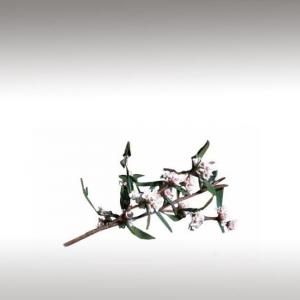

Botanical Name: Agonis fragrans
Common Method of Extraction: Steam distillastion
Part Typically Used: Flowers and leaves
Color: Pale yallow
Consistency: Thin
Perfumery Note: Middle
Strength of Initial Aroma: Sweet, medicinal aroma with floral undertones.
"A pleasant fresh cineolic odour with a hint of a citrus note (which becomes more pronounced after a few minutes) mixed with a slight spicy Cinnamon tonality and sweet balsamic undertones. The dry down is very faint being sweet, soapy and woody balsamic".
Fragonia is produced in Australia and is still a relatively new essential oil. It is becoming very popular among aromatherapists because it has similar property of Tea Tree but has a citrus, spicy floral note.
Fragonia is a shrub reaching approximately 2,4m in height. It has erect flowering branches and thick rigid leaves along with small clusters of five white petalled flowers and a pretty pink centre. Flowering takes place between January and May typically. It is found on the south coast of Western Australia. Recognised as coarse Tea Tree by the cut flower industry, it has only recently been given its common name, which reflects the fragrant nature of both the foliage and the extracted oil.
Fragonia is grown in plantations around south west Western Australia.The harvesting is done mechanically, the branchlets and leaves are cut, the leaves are collected and then placed into a stainless steel boiler. The trees are harvested and are then steam distilled for around 1 to 1,5 hours.
Chemical structure:
This essential oil is a perfect ratio oxides - monoterpenes and monoterpenols. It is a gentle oil.
It is an extremely balanced oil, with the oxides (cineol, which gives Eucalyptus oil its distinctive aroma), monoterpines (alpha pinene), and monoterpenols (linalol) in a near perfect 1:1:1 ratio.
In working with Fragonia, it is important to know the chemical constituents and the properties associated with them. Possible uses for these constituents can be found in many publications, including Mark Webb's book "Bush Sense", and are as follows:
Monoterpenes (30-39%):
a-pinene - anti-inflammatory
limonene - anticancer, antiseptic, bactericide, expectorant, fungastatic, sedative, viricide
Oxides (26-32%):
1,8-cineole - antibronchitic, anticatarrh, antiseptic, antitussive, CNS stimulant, expectorant and respiratory anti-inflamatory. Increases dermal uptake by up to 95 times.
Monoterpenols (23-30%):
linalool - antiseptic (5 x phenol), bactericide, fungicide, perfumery, sedative, spasmolytic, viricide
terpenen-4-ol - antiallergic, antifungal, antihistomanic
a-terpineol - antiallergenic, antiasthmatic, antiseptic, antitussive, bactericide, expectorant
geraniol - antiseptic, cancer preventative, candidicide, fungacide, perfumery, sedative.
Common Method of Extraction: Steam distillastion
Part Typically Used: Flowers and leaves
Color: Pale yallow
Consistency: Thin
Perfumery Note: Middle
Strength of Initial Aroma: Sweet, medicinal aroma with floral undertones.
"A pleasant fresh cineolic odour with a hint of a citrus note (which becomes more pronounced after a few minutes) mixed with a slight spicy Cinnamon tonality and sweet balsamic undertones. The dry down is very faint being sweet, soapy and woody balsamic".
Fragonia is produced in Australia and is still a relatively new essential oil. It is becoming very popular among aromatherapists because it has similar property of Tea Tree but has a citrus, spicy floral note.
Fragonia is a shrub reaching approximately 2,4m in height. It has erect flowering branches and thick rigid leaves along with small clusters of five white petalled flowers and a pretty pink centre. Flowering takes place between January and May typically. It is found on the south coast of Western Australia. Recognised as coarse Tea Tree by the cut flower industry, it has only recently been given its common name, which reflects the fragrant nature of both the foliage and the extracted oil.
Fragonia is grown in plantations around south west Western Australia.The harvesting is done mechanically, the branchlets and leaves are cut, the leaves are collected and then placed into a stainless steel boiler. The trees are harvested and are then steam distilled for around 1 to 1,5 hours.
Chemical structure:
This essential oil is a perfect ratio oxides - monoterpenes and monoterpenols. It is a gentle oil.
It is an extremely balanced oil, with the oxides (cineol, which gives Eucalyptus oil its distinctive aroma), monoterpines (alpha pinene), and monoterpenols (linalol) in a near perfect 1:1:1 ratio.
In working with Fragonia, it is important to know the chemical constituents and the properties associated with them. Possible uses for these constituents can be found in many publications, including Mark Webb's book "Bush Sense", and are as follows:
Monoterpenes (30-39%):
a-pinene - anti-inflammatory
limonene - anticancer, antiseptic, bactericide, expectorant, fungastatic, sedative, viricide
Oxides (26-32%):
1,8-cineole - antibronchitic, anticatarrh, antiseptic, antitussive, CNS stimulant, expectorant and respiratory anti-inflamatory. Increases dermal uptake by up to 95 times.
Monoterpenols (23-30%):
linalool - antiseptic (5 x phenol), bactericide, fungicide, perfumery, sedative, spasmolytic, viricide
terpenen-4-ol - antiallergic, antifungal, antihistomanic
a-terpineol - antiallergenic, antiasthmatic, antiseptic, antitussive, bactericide, expectorant
geraniol - antiseptic, cancer preventative, candidicide, fungacide, perfumery, sedative.
Submitted by OperaDreamhouse (May 4, 2015)
Geranium Essential Oil (Pelargonium Graveolens) ☸ Essential oils ☸ Base / General
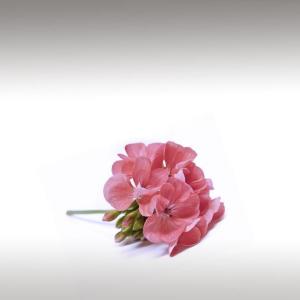

Botanical Name: Pelargonium graveolens
Common Method of Extraction: Steam distillation
Part Typically Used: Flowers, leaves
Color: Ranges in Color From Clear to Amber
Consistency: Thin
Perfumery Note: Middle
Strength of Initial Aroma: Floral, fresh, sweet, with a fruity note.
Common names include Rose Geranium, Old Fashion Rose Geranium, and Rose-Scent Geranium. Pelargonium Graveolens is also known by taxonomic synonyms "Geranium Terebinthinaceum Cav."
The true Pelargonium Graveolens is an uncommon species in the Pelargonium genus, which is native to South Africa, Zimbabwe and Mozambique. Plants sometimes cultivated under this name and also as Pelargonium "Graveolens" differ from wild specimens and are of hybrid origin.
Geranium is a perennial shrub with pointy, serrated leaves and small, pink, aromatic flowers. Like Rose, there are many species and cultivars of Geranium (in a variety of colors) but Pelargonium Graveolens is generally the species used for aromatherapy purposes.
Pelargonium Graveolens cultivars have a wide variety of smells, including Rose, Citrus, Mint, Coconut and Nutmeg, as well as various fruits. However, the most commercially important varieties are those with Rose scents.
Rose Geranium has a Rose - like aroma and, as an essential oil in aromatherapy, it is often used to either adulterate rose oil or as a substitute for Rose oil. However, both plants are botanically different.
There are about 700 different varieties of the plant, yet only 10 supply essential oil in viable quantities, as the normal garden geranium produce far too little oil for extraction.
Pelargonium is a Greek word derived from Palargos meaning "Stork". The French Chemist Recluz was the first to distil the leaves of Geranium in 1819.
Pelargonium Graveolens is native to South Africa. During the 17th century, it was introduced to Europe and is now cultivated in such areas such as Spain, Italy and France due to it's fragrance which is sold commercially.
Chemical structure:
The essential oil is composed of various chemical constituentsand includes a-pinene, myrcene, limonene, menthone, linalool, geranyl acetate, citronellol, geraniol and geranyl butyrate.
A modern analysis listed the presence of over 50 organic compounds in the essential oil of Pelargonium Graveolens from an Australian source. Analyses of Indian Geranium oils indicated a similar phytochemical profile, and showed that the major constituents (in terms of % composition) were citronellol + nerol and geraniol.
Common Method of Extraction: Steam distillation
Part Typically Used: Flowers, leaves
Color: Ranges in Color From Clear to Amber
Consistency: Thin
Perfumery Note: Middle
Strength of Initial Aroma: Floral, fresh, sweet, with a fruity note.
Common names include Rose Geranium, Old Fashion Rose Geranium, and Rose-Scent Geranium. Pelargonium Graveolens is also known by taxonomic synonyms "Geranium Terebinthinaceum Cav."
The true Pelargonium Graveolens is an uncommon species in the Pelargonium genus, which is native to South Africa, Zimbabwe and Mozambique. Plants sometimes cultivated under this name and also as Pelargonium "Graveolens" differ from wild specimens and are of hybrid origin.
Geranium is a perennial shrub with pointy, serrated leaves and small, pink, aromatic flowers. Like Rose, there are many species and cultivars of Geranium (in a variety of colors) but Pelargonium Graveolens is generally the species used for aromatherapy purposes.
Pelargonium Graveolens cultivars have a wide variety of smells, including Rose, Citrus, Mint, Coconut and Nutmeg, as well as various fruits. However, the most commercially important varieties are those with Rose scents.
Rose Geranium has a Rose - like aroma and, as an essential oil in aromatherapy, it is often used to either adulterate rose oil or as a substitute for Rose oil. However, both plants are botanically different.
There are about 700 different varieties of the plant, yet only 10 supply essential oil in viable quantities, as the normal garden geranium produce far too little oil for extraction.
Pelargonium is a Greek word derived from Palargos meaning "Stork". The French Chemist Recluz was the first to distil the leaves of Geranium in 1819.
Pelargonium Graveolens is native to South Africa. During the 17th century, it was introduced to Europe and is now cultivated in such areas such as Spain, Italy and France due to it's fragrance which is sold commercially.
Chemical structure:
The essential oil is composed of various chemical constituentsand includes a-pinene, myrcene, limonene, menthone, linalool, geranyl acetate, citronellol, geraniol and geranyl butyrate.
A modern analysis listed the presence of over 50 organic compounds in the essential oil of Pelargonium Graveolens from an Australian source. Analyses of Indian Geranium oils indicated a similar phytochemical profile, and showed that the major constituents (in terms of % composition) were citronellol + nerol and geraniol.
Submitted by OperaDreamhouse (April 22, 2015)
Lavender Essential Oil (Lavandula Angustifolia) ☸ Essential oils ☸ Base / General
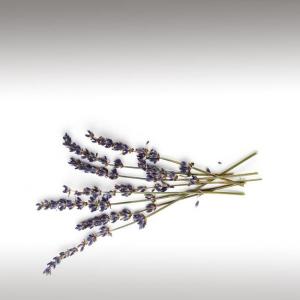

Botanical Name: Lavandula angustifolia
Common Method of Extraction: Steam Distilled
Part Typically Used: Flowers
Color: Clear
Consistency: Thin
Perfumery Note: Middle / Top
Strength of Initial Aroma: Very fine green floral, sweet herbaceous, penetrating, clear and fresh.
The species name Angustifolia is Latin for "Narrow leaf".
Lavandula Angustifolia (Lavender or English Lavender also common Lavender, True Lavender, Narrow - Leaved Lavender), formerly Lavandula Officinalis, is a flowering plant in the family Lamiaceae, native to the western Mediterranean, primarily the Pyrenees and other mountains in northern Spain.
The name is derived from the Latin word "Lavera" which means "To wash" and the Romans used it frequently in their bath routine, and it is said to have been introduced by them into England, where it soon was a firm favorite.
It was a favorite for screwing on the floor, since it released an aroma when walked upon and it is often used these days in toilet water, as an insecticide or in sachets to be placed between linen.
It is a strongly aromatic shrub growing as high as 1 to 2 metres tall. The leaves are evergreen, 2 - 6 centimetres long, and 4 - 6 millimetres broad. The flowers are pinkish - purple (Lavender - coloured), produced on spikes 2 - 8 cm long at the top of slender, leafless stems 10 - 30 cm long.
It is popular for its colourful flowers, its fragrance and its ability to survive with low water consumption. It does not grow well in continuously damp soil. It is fairly tolerant of low temperatures.
Lavandula Angustifolia is the True Lavender. It is produced throughout the world, although France is considered the premier growing region. In the world of essential oils, Lavender is one of the most commonly used due to its versatility and pleasant scent.
Lavender oil is extracted from the flowering tops by steam distillation and yields 1,4 % - 1,6 %.
True Lavender oil, which is obtained by steam distillation of the flowering tops of the plant, is non-toxic and has a full flowery aroma. The Bulgarian grown Lavender has a sweet smell. The aroma of Lavandin is usually more camphoraceous. Tuscan Lavender has a refreshing topnote.
Common Method of Extraction: Steam Distilled
Part Typically Used: Flowers
Color: Clear
Consistency: Thin
Perfumery Note: Middle / Top
Strength of Initial Aroma: Very fine green floral, sweet herbaceous, penetrating, clear and fresh.
The species name Angustifolia is Latin for "Narrow leaf".
Lavandula Angustifolia (Lavender or English Lavender also common Lavender, True Lavender, Narrow - Leaved Lavender), formerly Lavandula Officinalis, is a flowering plant in the family Lamiaceae, native to the western Mediterranean, primarily the Pyrenees and other mountains in northern Spain.
The name is derived from the Latin word "Lavera" which means "To wash" and the Romans used it frequently in their bath routine, and it is said to have been introduced by them into England, where it soon was a firm favorite.
It was a favorite for screwing on the floor, since it released an aroma when walked upon and it is often used these days in toilet water, as an insecticide or in sachets to be placed between linen.
It is a strongly aromatic shrub growing as high as 1 to 2 metres tall. The leaves are evergreen, 2 - 6 centimetres long, and 4 - 6 millimetres broad. The flowers are pinkish - purple (Lavender - coloured), produced on spikes 2 - 8 cm long at the top of slender, leafless stems 10 - 30 cm long.
It is popular for its colourful flowers, its fragrance and its ability to survive with low water consumption. It does not grow well in continuously damp soil. It is fairly tolerant of low temperatures.
Lavandula Angustifolia is the True Lavender. It is produced throughout the world, although France is considered the premier growing region. In the world of essential oils, Lavender is one of the most commonly used due to its versatility and pleasant scent.
Lavender oil is extracted from the flowering tops by steam distillation and yields 1,4 % - 1,6 %.
True Lavender oil, which is obtained by steam distillation of the flowering tops of the plant, is non-toxic and has a full flowery aroma. The Bulgarian grown Lavender has a sweet smell. The aroma of Lavandin is usually more camphoraceous. Tuscan Lavender has a refreshing topnote.
Submitted by OperaDreamhouse (April 22, 2015)
Peppermint Essential Oil (Mentha x Piperita) ☸ Essential oils ☸ Base / General
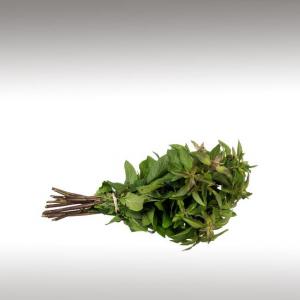

Botanical Name: Mentha x piperita
Common Method of Extraction: Steam Distilled
Part Typically Used: Leaves and Flowers/Buds
Color: Clear with a Yellow Tinge
Consistency: Thin
Perfumery Note: Top
Strength of Initial Aroma: Minty, strong, reminiscent of peppermint candies, but more concentrated. More fragrant than spearmint. Fresh, very minty, hot, herbaceous, with a vegetative back note.
Note: If you find Peppermint oil to be a bit too intense, you may enjoy working with Spearmint oil.
Peppermint (Mentha × Piperita, also known as Mentha Balsamea Willd) is a Hybrid mint, a cross between Watermint and Spearmint. The plant, indigenous to Europe and the Middle East, is now widespread in cultivation in many regions of the world.
Peppermint is a fast-growing plant, once it sprouts, it spreads very quickly. Being a hybrid, it is usually sterile, producing no seeds and reproducing only vegetatively, spreading by itsrhizomes. If placed, it can grow anywhere, with a few exceptions.
It is a perennial plant growing to 30 - 90 cm tall, with smooth stems, square in cross section. The leaves are from 4 - 9 cm long and 1,5 - 4 cmbroad, dark green with reddish veins, and with an acute apex and coarsely toothed margins. The leaves and stems are usually slightly fuzzy. The flowers are purple, 6 - 8 mm long, with a four - lobed corolla about 5 mm diameter. Flowering is from mid to late summer.
Peppermint Latin name, Mentha Piperita, comes from the Greek Mentha, the name of a mythical nymph thought to have metamorphosed into the plant, and the Latin Piper, meaning Pepper.
MenthaPpiperita has been found in Egyptian tombs dating back to 1000 B.C. and there is evidence that Peppermint has a long history in Europe, China, and Japan.
It is one of the world’s oldest medicinal herbs, and is used in both Eastern and Western traditions. Ancient Greek, Roman and Egyptian cultures used the herb in cooking and medicine.
Peppermint is currently one of the most economically important aromatic and medicinal crops produced in the U.S. The world production of Peppermint oil is about 8000 tons per year 1.
Chemical structure:
Peppermint has a high menthol content. The oil also contains menthone and menthyl esters, particularly menthyl acetate.
Dried Peppermint typically has 0,3 - 0,4% of volatile oil containing menthol (7 - 48%), menthone (20 - 46%), menthyl acetate (3 - 10%), menthofuran (1 - 17%) and 1,8-cineole (3 - 6%). Peppermint oil also contains small amounts of many additional compounds including limonene, pulegone, caryophyllene and pinene.
Menthol is the primary component of the essential oil of Peppermint. It occurs naturally as a colorless crystal or powder. Menthol is mostly responsible for the spasmolytic nature of peppermint.
Peppermint also contains terpenoids and flavonoids such as eriocitrin, hesperidin and kaempferol 7 - O-rutinoside.
Mild climate stress in the growing conditions of the plant increases the oil content and sesquiterpene levels in the oil.
Common Method of Extraction: Steam Distilled
Part Typically Used: Leaves and Flowers/Buds
Color: Clear with a Yellow Tinge
Consistency: Thin
Perfumery Note: Top
Strength of Initial Aroma: Minty, strong, reminiscent of peppermint candies, but more concentrated. More fragrant than spearmint. Fresh, very minty, hot, herbaceous, with a vegetative back note.
Note: If you find Peppermint oil to be a bit too intense, you may enjoy working with Spearmint oil.
Peppermint (Mentha × Piperita, also known as Mentha Balsamea Willd) is a Hybrid mint, a cross between Watermint and Spearmint. The plant, indigenous to Europe and the Middle East, is now widespread in cultivation in many regions of the world.
Peppermint is a fast-growing plant, once it sprouts, it spreads very quickly. Being a hybrid, it is usually sterile, producing no seeds and reproducing only vegetatively, spreading by itsrhizomes. If placed, it can grow anywhere, with a few exceptions.
It is a perennial plant growing to 30 - 90 cm tall, with smooth stems, square in cross section. The leaves are from 4 - 9 cm long and 1,5 - 4 cmbroad, dark green with reddish veins, and with an acute apex and coarsely toothed margins. The leaves and stems are usually slightly fuzzy. The flowers are purple, 6 - 8 mm long, with a four - lobed corolla about 5 mm diameter. Flowering is from mid to late summer.
Peppermint Latin name, Mentha Piperita, comes from the Greek Mentha, the name of a mythical nymph thought to have metamorphosed into the plant, and the Latin Piper, meaning Pepper.
MenthaPpiperita has been found in Egyptian tombs dating back to 1000 B.C. and there is evidence that Peppermint has a long history in Europe, China, and Japan.
It is one of the world’s oldest medicinal herbs, and is used in both Eastern and Western traditions. Ancient Greek, Roman and Egyptian cultures used the herb in cooking and medicine.
Peppermint is currently one of the most economically important aromatic and medicinal crops produced in the U.S. The world production of Peppermint oil is about 8000 tons per year 1.
Chemical structure:
Peppermint has a high menthol content. The oil also contains menthone and menthyl esters, particularly menthyl acetate.
Dried Peppermint typically has 0,3 - 0,4% of volatile oil containing menthol (7 - 48%), menthone (20 - 46%), menthyl acetate (3 - 10%), menthofuran (1 - 17%) and 1,8-cineole (3 - 6%). Peppermint oil also contains small amounts of many additional compounds including limonene, pulegone, caryophyllene and pinene.
Menthol is the primary component of the essential oil of Peppermint. It occurs naturally as a colorless crystal or powder. Menthol is mostly responsible for the spasmolytic nature of peppermint.
Peppermint also contains terpenoids and flavonoids such as eriocitrin, hesperidin and kaempferol 7 - O-rutinoside.
Mild climate stress in the growing conditions of the plant increases the oil content and sesquiterpene levels in the oil.
Submitted by OperaDreamhouse (April 20, 2015)
Peppermint Essential Oil (Mentha x Piperita) ☸ Essential oils ☸ Medicine / Health


Contraindications: Inhalation of large doses of menthol may lead to dizziness, confusion, muscle weakness, nausea and double vision.
Children: Peppermint oil is linked to causing seizures in children. Avoid dermal use on children under 6 years. Do not apply undiluted Peppermint essential oils to the feet, particularly on infants and children under the age of 12.
For more than 100 years, physicians have understood the importance of this, and have used pure Peppermint in the treatment of nasal congestion and sinusitis.
Children: Peppermint oil is linked to causing seizures in children. Avoid dermal use on children under 6 years. Do not apply undiluted Peppermint essential oils to the feet, particularly on infants and children under the age of 12.
For more than 100 years, physicians have understood the importance of this, and have used pure Peppermint in the treatment of nasal congestion and sinusitis.
Submitted by OperaDreamhouse (April 20, 2015)
Page 24 of 48

